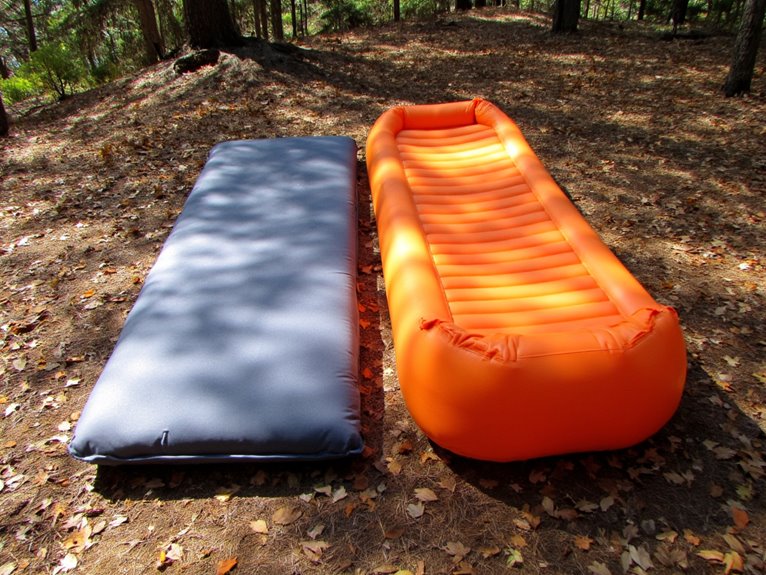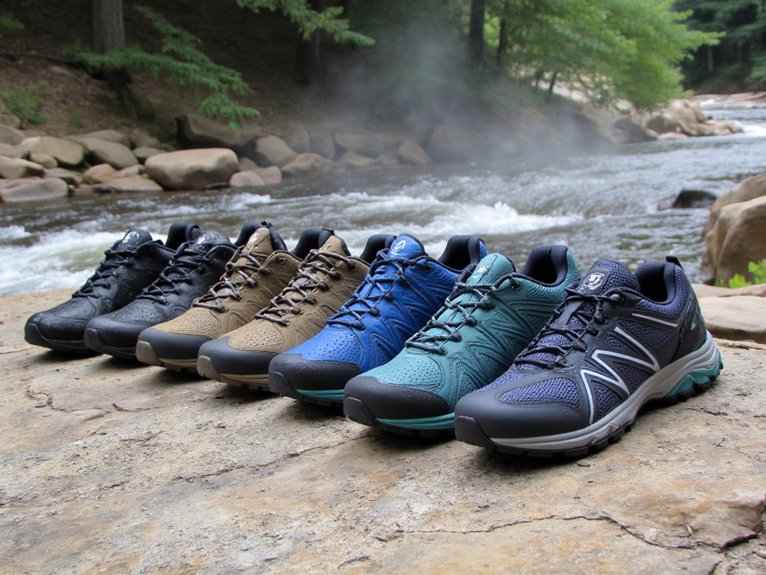What Is the Ideal Weight for a Thru Hike Pack?
For most thru-hikers, an ideal pack weight falls between 30-40 pounds, a range that corresponds to approximately 20-25% of their body weight. However, this can vary greatly depending on factors such as body type, trail conditions, and personal preferences. Understanding the nuances of base weight, the 'Big Three' (shelter, sleep, and pack), and individual priorities is vital in achieving a desirable pack weight. By prioritizing essential gear, choosing multi-use items, and refining cooking setups, hikers can strike a balance between comfort and weight. There's more to delve into on this topic, and the details can make all the difference.
We are supported by our audience. When you purchase through links on our site, we may earn an affiliate commission, at no extra cost for you. Learn more. Last update on 4th December 2025 / Images from Amazon Product Advertising API.
Defining the Ideal Pack Weight
Defining the Ideal Pack Weight
A general rule of thumb for thru-hikers is to aim for a backpack weight that's no more than 20-25% of their body weight, which translates to a sweet spot of around 30-40 pounds for most adults.
This range allows for a comfortable carrying capacity without compromising on essential gear.
A lighter pack enables hikers to move more efficiently, reducing fatigue and the risk of injury.
However, it's essential to strike a balance between pack weight and the necessities for a safe and enjoyable thru-hike.
Factors Affecting Pack Weight Needs
In determining the ideal pack weight for a thru-hike, several factors come into play.
Two critical considerations are the hiker's body type and size, as well as the trail conditions and terrain they will encounter.
Understanding these factors is essential to striking the right balance between carrying enough gear and avoiding unnecessary weight.
Body Type and Size
Body type and size substantially influence the ideal pack weight, as hikers with a larger or more muscular build can comfortably carry a heavier load than their petite counterparts.
This is because a stronger, more muscular individual can distribute the weight more efficiently, reducing the strain on their joints and back.
Conversely, smaller or more slender hikers may find it challenging to carry the same load, increasing their risk of fatigue and injury.
When planning a thru-hike, it's essential to consider your body type and size when determining the ideal pack weight.
Trail Conditions and Terrain
Rugged terrain, unpredictable weather, and remnant snowfields can substantially impact the weight and contents of a thru-hiker's pack, as the need for additional gear and supplies can add pounds to an already heavy load.
For instance, hiking in areas with frequent rain or snow requires extra waterproof gear and warm layers, increasing pack weight.
In the same vein, traversing rugged terrain may necessitate carrying additional safety equipment, such as a first aid kit or emergency shelter.
Understanding the specific trail conditions and terrain of your thru-hike will help you determine the essential items to include in your pack, and how to balance their weight with your overall comfort and safety.
The Importance of Base Weight
In thru-hiking, base weight is a critical factor in determining the overall weight of your pack.
By focusing on lightweight gear options and prioritizing essential items, hikers can substantially reduce their base weight, resulting in a more comfortable and efficient hiking experience.
In the following sections, we'll delve into the importance of base weight and provide practical tips for optimizing your pack's weight distribution.
Lightweight Gear Options
By carefully selecting lightweight gear options, thru-hikers can substantially reduce their base weight, thereby increasing overall comfort and efficiency on the trail.
One effective strategy is to opt for ultralight backpacking gear, such as silnylon tents and tarps, which offer impressive weight savings without sacrificing performance.
Another approach is to choose multi-use items, like a sarong that doubles as a blanket and a towel.
Additionally, consider swapping traditional camping stoves for lighter alternatives like canister stoves or even a DIY alcohol stove.
Essential Item Prioritization
Accurately prioritizing essential items is crucial to achieving an ideal base weight, as it allows thru-hikers to strike a balance between bringing necessary gear and avoiding unnecessary bulk.
By focusing on the most critical items, hikers can minimize their pack weight while still ensuring they have what they need to stay safe and comfortable on the trail.
Some essential items to prioritize include:
- Shelter and sleeping gear (tent, sleeping bag, pad)
- Clothing and layers for varying weather conditions
- Navigation tools (map, compass, GPS)
- First aid kit and personal hygiene items
- Water treatment and hydration gear
Average Weights for Thru-Hikers
Thru-hikers typically aim to carry a base weight of around 20-30 pounds, with some seasoned backpackers managing to whittle it down to as low as 15 pounds.
This range allows for a comfortable balance between carrying essential gear and minimizing weight.
On the Appalachian Trail, for example, the average base weight is around 25-28 pounds, while Pacific Crest Trail hikers often aim for 20-22 pounds.
It's worth noting that these weights can vary greatly depending on individual needs, climate, and personal preferences.
Understanding these averages can help you set realistic goals for your own thru-hike, ensuring you're well-prepared without sacrificing comfort or safety.
The Big Three: Shelter, Sleep, Pack
Among the most critical components of a thru-hiker's gear, shelter, sleep, and pack systems are often referred to as the 'Big Three,' as they have the greatest impact on overall pack weight and comfort.
These three systems can account for up to 70% of a hiker's total pack weight, making them vital areas for weight optimization.
Shelter: Tarps, tents, and stakes that provide reliable protection from the elements.
Sleep: Sleeping bags, pads, and groundsheets that promote a good night's rest.
Pack: Frames, bags, and suspension systems that comfortably carry all your gear.
Multi-use items: Look for gear that serves multiple purposes to reduce overall weight.
Ultralight options: Consider lightweight alternatives, but weigh the cost and durability trade-offs.
Clothing and Accessories Weigh-In
What constitutes the ideal clothing and accessories for a thru-hike, and how can you strike a balance between functionality, comfort, and weight?
The answer lies in choosing multi-functional, lightweight, and breathable clothing that can adapt to varying weather conditions.
Consider a base layer, insulating layer, and waterproof jacket as the foundation of your clothing system.
Accessories like hats, gloves, and socks should be chosen for their warmth, moisture-wicking properties, and durability.
A good rule of thumb is to aim for a clothing and accessories weight of around 10-12 pounds, depending on the season and location of your hike.
Food and Water Weight Considerations
When provisioning for a thru-hike, the weight and bulk of food and water can quickly add up, making it vital to strike a balance between sustenance and pack weight. A thru-hiker's daily caloric needs are significant, and the weight of food can be substantial. Add to that the weight of water, which can range from 2-8 pounds per day, depending on the terrain and climate.
To minimize food and water weight, consider the following strategies:
- Plan meals carefully to avoid excess food weight
- Choose lightweight, high-calorie foods
- Ration food to minimize leftovers
- Use water treatment methods instead of carrying heavy water bottles
- Cache food and water along the trail to reduce pack weight
Regarding provisioning for a thru-hike, the weight and bulk of food and water can quickly add up, making it essential to strike a balance between sustenance and pack weight.
The Role of Personal Preferences
Personal preferences play a significant role in determining the ideal weight of a thru-hike pack, as they influence the level of comfort and convenience hikers are willing to sacrifice for the sake of a lighter load.
For instance, some hikers prioritize a good night's sleep and consequently insist on carrying a comfortable sleeping pad and bag, while others are content with a minimalist setup.
In the same vein, some may be willing to carry a few extra pounds of luxury items, such as a camp chair or a book, while others prioritize a bare-bones approach.
Understanding individual preferences is essential in striking a balance between comfort, convenience, and pack weight.
Achieving the Ideal Pack Weight
By recognizing the impact of personal preferences on pack weight, hikers can now focus on implementing strategies to achieve an ideal pack weight that balances comfort and convenience with the need to keep loads light.
To achieve this balance, consider the following strategies:
Prioritize gear: Focus on the most essential items and eliminate unnecessary equipment.
Choose multi-use gear: Select items that serve multiple purposes to reduce overall weight and bulk.
Opt for lightweight alternatives: Consider swapping heavy items for lighter options without sacrificing performance.
Pack clothes strategically: Bring only what's necessary and plan outfits carefully to minimize clothing weight.
Refine your cooking setup: Streamline your cooking gear to reduce weight and complexity.


